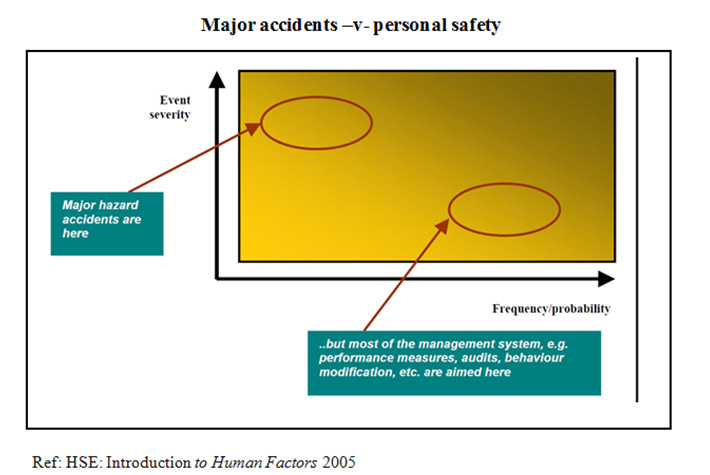EQUIPMENT FAILURES: HUMAN FACTORS
HUMAN FACTORS is perhaps the largest contributory factor to failures of engineering equipment. Even when equipment failures are classified as being caused by technical reasons closer investigation shows that in more than 80% of cases, human factors had something to do with what happened. In spite of this, the subject of human factors is one of the least well considered in the operation and maintenance of engineering equipment. It is as if it is either too difficult to investigate or conversely, too easy to ignore.

What are ‘Human Factors’ all about?
It’s simply about what people are asked to do, who does it, and what organisational system they are working within. All these three things are active at the same time, all the time, and so need to be considered as a set. If an accident or failure is classified as having ‘human factors’ as a contributory cause, then it means that some or all of the three elements had an influence on what happened.
Discussion -v- Action
There are banks of literature discussing the subject of Human Factors in avoiding and causing failures and accidents, so there is little justification in pretending that the subject is hidden. One of the most useful sources of reference is the UK Health and Safety Executive (HSE) website which contains excellent technical coverage of the subject spread across several documents; see the reference list at the end of this article.
Unfortunately, it the excellent guidance given in these articles seems to promote more agreement and discussion than it does action. You can test this for yourself by reading through one of the simpler summary documents such as www.hse.gov.uk/humanfactors/topics/toolkitintro.pdf
This document (it is 8 pages) provides as useful a summary as any to the reasons why human factors contribute to accidents. Yes, it recognises the existence of companies’ safety ‘motherhood statements’ management systems, and procedures of all types but puts forward the simple conclusion that they don’t seem to have as much effect as they should.
The figure shown below goes some way to explaining the reason. It’s a simple diagram but rings true with many sites operating engineering plant such as pressure equipment, rotating machinery and lifting equipment. Having written procedures, audits and what-have-you is a fine idea, but it’s how they are targeted and what happens as a result of having them that prevents failures and accidents.

Let’s testing this finding
At MATTHEWS Integrity Hub: HEAD OFFICE, we looked at one petrochemical-type operating site which had had a number of serious failures over the past five years, all causing LTIs, significant damage to the plant itself, or lost production. The main reasons behind four of these incidents came out as:
- Incident 1: Fatigue failure of pipework causing loss of containment of hazardous substance and a local explosion.
- Incident 2: Scaling-up of alarm and control trips on a shell boiler leading to catastrophic failure of the pressure envelope.
- Incident 3: Cracking of a brittle valve casting during a hydraulic test resulting in missile damage and injury to test personnel
- Incident 4: Failure of a compressor bearing due to a misaligned coupling and loose fitted bolts. Expensive asset damage and plant downtime.
There’s nothing particularly unusual or unique about any of these failures, they have all happened before on many sites, and will happen again. The interesting and common features of them all however are:
- Although they are well-known failure modes, they are not common occurrences i.e. they are low probability, high consequence incidents
- They are different types of incident but Human Factors were involved in all of them. If everyone had done their job correctly, none of them would have happened
- The site involved was awash with safety procedures but none of the failure events that actually occurred were covered by procedures written specifically to anticipate them and stop them happening.
Findings like this are commonplace when you look at engineering failures and accidents. We like the following quote from the HSE Human Factors Toolkit document:
‘Rather than being the main instigators of an accident, operators tend to be the inheritors of system defects created by poor design, incorrect installation, faulty maintenance and bad management decisions. Their part is usually that of adding the final garnish to a lethal brew whose ingredients have already been long in the cooking’
Read some more HSE wisdom about this subject
‘Reducing error and influencing behaviour (HSG48)’ is the key document in understanding HSE’s approach to human factors. It gives a simple introduction to generic industry guidance and discusses the three interrelated aspects that must be considered: the job, the individual and the organisation. There’s other good stuff available also. You don’t have to reinvent the wheel; it’s there already
See our linked article HSE Enforcement;Do you feel lucky? covering the HSE Enforcement Management Model (EMM)
See also these references
‘Reducing Error and Influencing Behaviour, HSG48’ Second Edition, 1999:HSE
The HID Regulatory Model http://intranet/hid/hid-regulatory-model.pdf
Operational DG: Inspection of Competence Management Systems at COMAH Establishments
Performance Influencing Factors (PIFs) www.hse.gov.uk/humanfactors/topics/pifs.pdf
Can we help you further?
We will be pleased to hear about interested experiences you’ve had with engineering equipment failures. See our Failure Briefings reports for a variety of different examples. We’ve been involved in technical investigations; plant guarantee claims and legal disputes in many fields so always find them interesting. We are not part of any government body, association, institution, agency or employer. Nor do we officially represent any of them, so you can be assured that we can provide you with an objective viewpoint. We can’t comment on individual companies and incidents of course but are happy to discuss general technical situations or issues that you have.
Matthews Integrity Hub: HEAD OFFICE is OPEN EVERY DAY….0730 – 2200 Monday – Sunday…That’s correct, all week, every week, including holidays
 If we happen to miss your call, leave a message and we will call you back just as soon as we pick it up. Sorry, there’s no automated messages, call queueing, voice recognition tools or canned music. Try it and see.
If we happen to miss your call, leave a message and we will call you back just as soon as we pick it up. Sorry, there’s no automated messages, call queueing, voice recognition tools or canned music. Try it and see.
CONTACT US
Tel: 07746 771592 help@matthewsintegrity.co.uk





